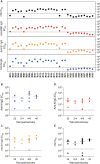Middle East Respiratory Syndrome Coronavirus Infection Elicits Long-lasting Specific Antibody, T and B Cell Immune Responses in Recovered Individuals
- PMID: 35675306
- PMCID: PMC9384236
- DOI: 10.1093/cid/ciac456
Middle East Respiratory Syndrome Coronavirus Infection Elicits Long-lasting Specific Antibody, T and B Cell Immune Responses in Recovered Individuals
Abstract
Background: The Middle East respiratory syndrome coronavirus (MERS-CoV) is a highly pathogenic zoonotic betacoronavirus and a global public health concern. Better undersetting of the immune responses to MERS-CoV is needed to characterize the correlates of protection and durability of the immunity and to aid in developing preventative and therapeutic interventions. Although MERS-CoV-specific circulating antibodies could persist for several years post-recovery, their waning raises concerns about their durability and role in protection. Nonetheless, memory B and T cells could provide long-lasting protective immunity despite the serum antibodies levels.
Methods: Serological and flow cytometric analysis of MERS-CoV-specific immune responses were performed on samples collected from a cohort of recovered individuals who required intensive care unit (ICU) admission as well as hospital or home isolation several years after infection to characterize the longevity and quality of humoral and cellular immune responses.
Results: Our data showed that MERS-CoV infection could elicit robust long-lasting virus-specific binding and neutralizing antibodies as well as T- and B-cell responses up to 6.9 years postinfection regardless of disease severity or need for ICU admission. Apart from the persistent high antibody titers, this response was characterized by B-cell subsets with antibody-independent functions as demonstrated by their ability to produce tumor necrosis factor α (TNF-α), interleukin (IL)-6, and interferon γ (IFN-γ) cytokines in response to antigen stimulation. Furthermore, virus-specific activation of memory CD8+ and CD4+ T cell subsets from MERS-recovered patients resulted in secretion of high levels of TNF-α, IL-17, and IFN-γ.
Conclusions: MERS-CoV infection could elicit robust long-lasting virus-specific humoral and cellular responses.
Keywords: MERS-CoV; T cells; antibodies; coronaviruses; immunity; longevity.
© The Author(s) 2022. Published by Oxford University Press on behalf of Infectious Diseases Society of America. All rights reserved. For permissions, please e-mail: journals.permissions@oup.com.
Conflict of interest statement
Potential conflicts of interest. A. M. H. reports consultation fees from SaudiVax ltd and US10849972B2 patent (Trimeric S1-CD40L fusion protein vaccine against Middle East respiratory syndrome-coronavirus), US10806784B1 patent (composition and method for treating MERS), US11154612B2 patent (MERS-CoV vaccine with trimeric S1-CD40L fusion protein), US11219685B1 patent (Intranasal MERS-CoV vaccine), US20220008530A1 patent application (MERS-CoV VACCINE COMPOSITION), US20220054629A1 patent application (nucleic acid based vaccine against middle east respiratory syndrome-coronavirus). All other authors report no potential conflicts. All authors have submitted the ICMJE Form for Disclosure of Potential Conflicts of Interest. Conflicts that the editors consider relevant to the content of the manuscript have been disclosed.
Figures





Similar articles
-
A Highly Immunogenic and Protective Middle East Respiratory Syndrome Coronavirus Vaccine Based on a Recombinant Measles Virus Vaccine Platform.J Virol. 2015 Nov;89(22):11654-67. doi: 10.1128/JVI.01815-15. Epub 2015 Sep 9. J Virol. 2015. PMID: 26355094 Free PMC article.
-
Live-attenuated bivalent measles virus-derived vaccines targeting Middle East respiratory syndrome coronavirus induce robust and multifunctional T cell responses against both viruses in an appropriate mouse model.Virology. 2018 Aug;521:99-107. doi: 10.1016/j.virol.2018.05.028. Epub 2018 Jun 11. Virology. 2018. PMID: 29902727 Free PMC article.
-
Novel chimeric virus-like particles vaccine displaying MERS-CoV receptor-binding domain induce specific humoral and cellular immune response in mice.Antiviral Res. 2017 Apr;140:55-61. doi: 10.1016/j.antiviral.2016.12.019. Epub 2016 Dec 28. Antiviral Res. 2017. PMID: 28040513 Free PMC article.
-
Progress of Middle East respiratory syndrome coronavirus vaccines: a patent review.Expert Opin Ther Pat. 2017 Jun;27(6):721-731. doi: 10.1080/13543776.2017.1281248. Epub 2017 Jan 25. Expert Opin Ther Pat. 2017. PMID: 28121202 Review.
-
Mucosal immunity in upper and lower respiratory tract to MERS-CoV.Front Immunol. 2024 Aug 30;15:1358885. doi: 10.3389/fimmu.2024.1358885. eCollection 2024. Front Immunol. 2024. PMID: 39281686 Free PMC article. Review.
Cited by
-
Beyond the Pandemic Era: Recent Advances and Efficacy of SARS-CoV-2 Vaccines Against Emerging Variants of Concern.Vaccines (Basel). 2025 Apr 17;13(4):424. doi: 10.3390/vaccines13040424. Vaccines (Basel). 2025. PMID: 40333293 Free PMC article. Review.
-
Identification of a Spike-Specific CD8+ T-Cell Epitope Following Vaccination Against the Middle East Respiratory Syndrome Coronavirus in Humans.J Infect Dis. 2024 Aug 16;230(2):e327-e332. doi: 10.1093/infdis/jiad612. J Infect Dis. 2024. PMID: 38195212 Free PMC article.
-
Immunogenicity of High-Dose MVA-Based MERS Vaccine Candidate in Mice and Camels.Vaccines (Basel). 2022 Aug 17;10(8):1330. doi: 10.3390/vaccines10081330. Vaccines (Basel). 2022. PMID: 36016218 Free PMC article.
-
Silent battles: immune responses in asymptomatic SARS-CoV-2 infection.Cell Mol Immunol. 2024 Feb;21(2):159-170. doi: 10.1038/s41423-024-01127-z. Epub 2024 Jan 15. Cell Mol Immunol. 2024. PMID: 38221577 Free PMC article. Review.
-
Rise in broadly cross-reactive adaptive immunity against human β-coronaviruses in MERS-recovered patients during the COVID-19 pandemic.Sci Adv. 2024 Mar;10(9):eadk6425. doi: 10.1126/sciadv.adk6425. Epub 2024 Feb 28. Sci Adv. 2024. PMID: 38416834 Free PMC article.
References
-
- Drosten C, Günther S, Preiser W, et al. . Identification of a novel coronavirus in patients with severe acute respiratory syndrome. N Engl J Med 2003; 348:1967–76. - PubMed
-
- Zaki AM, van Boheemen S, Bestebroer TM, Osterhaus AD, Fouchier RA. Isolation of a novel coronavirus from a man with pneumonia in Saudi Arabia. N Engl J Med 2012; 367:1814–20. - PubMed
-
- The world health organization (WHO) . Middle East respiratory syndrome. MERS situation update, October 2021. http://www.emro.who.int/health-topics/mers-cov/mers-outbreaks.html(accessed 29 November 2021).
Publication types
MeSH terms
Substances
LinkOut - more resources
Full Text Sources
Research Materials

